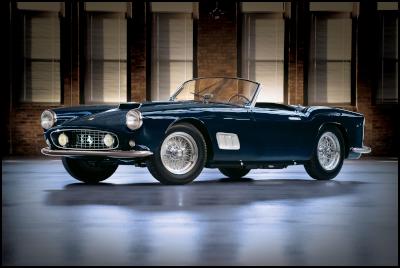Rare Ferrari in California
Rare Ferrari in California Aims for US Record Sale Price
A rare 1959 Ferrari 250 GT California Spyder will be the highlight car to come under the hammer at the event usually referred to as Pebble Beach of the US East Coast, the ‘Automobiles of Amelia Island’ auction, which will be organized by RM Auctions on 14 March 2009.

Click to enlarge
With a Ferrari California already holding world record for a classic Ferrari sold at auction, this immaculate Ferrari is expected to sell for US$2.9 million (AU$4.5 million/NZ$5.7 million) when it goes under the hammer at the US island resort.

Click to enlarge
The Ferrari 250 GT California Spyder is powered by – of course – a V12 engine, producing 240 bhp from its 2953cc in this particular variant.
The California name clearly signifies the importance of the American market to Ferrari. From the marque’s earliest days, Ferrari’s reputation for fast, elegant and desirable automobiles has been, at least as strong in the U.S. as in Europe, largely through the efforts of Luigi Chinetti and importers like John von Neumann
Chinetti, demonstrating the cars’ performance with his North American Racing Team and the support of Von Neumann, Parravano and others, exploited the fertile American market for Ferrari’s racing cars. The factory-affiliated teams’ success generated sales both of new racing cars and ex-team cars. Ferrari developed specific models, such as the two-liter Monzas and Mondials, for the North American market and the racing classes that attracted wealthy amateur – and some professional – drivers who could afford to buy and race the very best. The success of Ferrari in America supported the factory’s Grand Prix and sports racing car teams for years, just as it does today.
Ferrari’s burgeoning reputation and racing success also encouraged the market for its road cars with, again, specific models like the 375 America and Superamerica series being developed to satisfy American buyers’ desires for large engines and luxurious, long-legged gran turismos. The American dealers identified market niches and Ferrari built cars to fill them, small series of brilliantly integrated design and performance emphasizing the synergy among Ferrari and a few gifted designers and coachbuilders, notably Pinin Farina and Scaglietti.
At the same time Ferrari developed, built, raced and successfully sold a middle group of automobiles, dual-purpose gran turismos that traded luxury and creature comforts for light weight and high performance. Ranging from thinly disguised race cars like the 250MM and 340 Mexico, to sparsely-equipped road cars, Ferrari’s GT racers performed admirably in the long distance open road races of the fifties. The first of these dual-purpose Ferraris to achieve some semblance of series production was the second series of 250 GT Europa with three-liter Colombo engine. Bodied by Pinin Farina, some 36 were built and they demonstrated their effectiveness in competition. But GT competition was becoming more intense, so in 1956 Ferrari introduced two new versions of the 250 GT: the Boano/Ellena-bodied coupe road cars and the lightweight racing berlinettas built in limited numbers by Scaglietti to a Pinin Farina design. The latter earned its stripes in the Tour de France and has become synonymous with that great event which covered routes around France with competitive events at tracks and hillclimbs to determine the ultimate winner. Built on the same 2,600mm wheelbase chassis as the Boano/Ellena, the 250 GT Tour de France dominated gran turismo competition and its combination of exceptional performance and good looks has made it one of the most desirable Ferraris
At the same time Ferrari and Pinin Farina cooperated to create the first series of 250 GT cabriolets, the counterparts of the Boano/Ellena coupes. These luxurious and individually custom-built cabriolets were created for gentleman drivers who wanted open-air Ferraris to cruise the boulevards of sunny resorts with style and flair.
The American market, however, wanted something more than a fast, sparsely-equipped berlinetta or comfortably appointed cabriolet. Americans wanted a fast, sparsely-equipped convertible Ferrari sports car, the convertible counterpart of the Tour de France berlinettas. Whether it was Luigi Chinetti or John von Neumann who first pointed this out to Ferrari is immaterial. What is important, however, is that Ferrari responded with the California Spyder. Pinin Farina based the California Spyder on the design of the Tour de France. Scaglietti rendered Farina’s design in metal and whether it is the raked windshield, or clean roofless line, Scaglietti’s execution is without doubt one of the most beautiful Ferraris ever built.
California Spyder production began in 1958, and some 11 examples had been built by the time it was announced as a separate model in December 1958. One California Spyder was entered by NART at Sebring early in 1959 and driven by Richie Ginther and Howard Hively. It finished ninth overall (behind four Testarossas and four Porsche RSKs) and won the GT class. Le Mans in 1959 conclusively demonstrated the performance of the California Spyder as the NART-entered, alloy-bodied car driven by Bob Grossman and Fernand Tavano finishing fifth overall. Chinetti even found a way to make an impression on American drag racers with a sub-14 second steel-bodied California Spyder.
The car offered at the Amelia Island event, 1307 GT, is the twenty-third of the total fifty long wheelbase California Spyders and is unique among them for several desirable and distinctive features, including the unusual Superamerica-style front fender vents and an insert air intake on the hood. Delivered on March 27, 1959 to Prince Alvise Hercolani of Modena, its certificate of origin was issued by Ferrari on April 3, 1959.
Hercolani retained 1307 GT for barely six months, selling it to the racing driver and car dealer Wolfgang Seidel in October 1959. In fact, Seidel drove the car to the Grand Prix de Bruxelles in Belgium, as pictured in Jean-Paul Delsaux’s book Les Grand Prix de Bruxelles. Seidel in turn sold the car in 1961 to the car’s third owner, Rolf Helm of Germany before it was acquired by the fourth owner, William Morgan of Phoenix, Arizona. Morgan, who at the time lived in Wiesbaden, drove 1307 GT to Marseille, then put it on a boat to Corsica, where he spent a two-week vacation with his wife. From there, the car boarded a boat for Genoa before Morgan drove it to Modena.
Mr. Morgan would own the car for several more years. It was serviced at the factory in September 1963 and shipped to Pleasant Hills, California in 1965, as Morgan had since relocated back to the United States. 1307 GT was finally sold in September 22, 1966 to Mr. Edwin K. Niles, an attorney from California, who in turn sold it to Ron Semler of Studio City the following June.
Jong Ling owned it briefly in 1968 before selling it to Jim Swartout, who at the time was apparently only 29 years old. 1307 GT remained in Swartout’s ownership for the next 30 years, before it was sold in February 1999 to Jonas Liden of Sweden, who commissioned a full restoration at Autosport, Bachelli & Villa, in Bastiglia, Italy. After being shown at the Ferrari Owners Club UK National Concours in 2001, it was sold to Jean Guikas of Marseille before eventually being acquired in 2003 by the current owner.
After participating in the Texas 1000 and New England 1000, the car was more recently stripped down to bare metal and refinished in a very attractive deep blue, complemented by its original silver hardtop – a truly spectacular combination. It is believed that the hardtop was modified and adapted to this car during Wolfgang Seidel’s ownership. In addition to being shown at Meadow Brook in 2005, the car was also displayed at the 58th Annual Pebble Beach Concours d’Elegance in the special California Spyder category As presented, it remains in excellent condition throughout and of course retains its original type 128 D engine.
1307 GT is unique in several important respects. Most apparent is the switch box placed over the driveshaft tunnel just behind the shift lever. It contains the ignition switch and other controls which normally would be mounted on and below the dashboard and instrument panel, giving taller drivers more leg and knee room. As mentioned, 1307 GT also has distinctive Superamerica-style front fender vents formed from bright-finished aluminum. Fitted from new with the desirable and more reliable twin Marelli distributors, its three Weber carburetors breathe through factory-fitted velocity stacks and are contained within a cold air box, both highly desirable performance options fitted to only a few California Spyders.
As a long-wheelbase example, the trim, low lines of its topless coachwork are elegantly balanced by the placement of its wheels and tires. The overall effect is long, low, sleek and decidedly sporting. The California Spyder is as close as Ferrari came to building a sports car since the early Barchettas and only it and the later 275 GTB/4 NART Spyders have the elemental high speed open air attitude that sets these cars apart from their more common cabriolet counterparts.
ENDS


 SNAP: Survivors Deliver Vos Estis Lux Mundi Complaints Against Six Cardinals To Vatican Secretary Of State Parolin
SNAP: Survivors Deliver Vos Estis Lux Mundi Complaints Against Six Cardinals To Vatican Secretary Of State Parolin UNICEF Aotearoa NZ: Myanmar Earthquake A Further Blow For Millions Of Children
UNICEF Aotearoa NZ: Myanmar Earthquake A Further Blow For Millions Of Children Greenpeace: 'Desperate And Deceitful'- Deep Sea Mining Frontrunner Turns Its Back On Pacific Nations
Greenpeace: 'Desperate And Deceitful'- Deep Sea Mining Frontrunner Turns Its Back On Pacific Nations 350.org: Australia Announces Election Dates, Pacific Islanders Rally To Vote For Climate
350.org: Australia Announces Election Dates, Pacific Islanders Rally To Vote For Climate UNICEF Aotearoa NZ: Global Aid Funding Cuts - 14 Million Children At Increased Risk Of Severe Malnutrition And Death
UNICEF Aotearoa NZ: Global Aid Funding Cuts - 14 Million Children At Increased Risk Of Severe Malnutrition And Death Oxfam Aotearoa: Humanitarian Operations In Gaza Severely Hampered; Famine Risks Increasing
Oxfam Aotearoa: Humanitarian Operations In Gaza Severely Hampered; Famine Risks Increasing